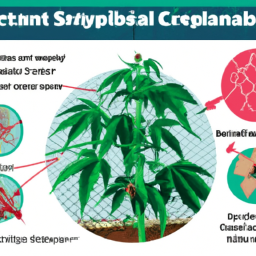Protect Your Cannabis Yields from Hop Latent Viroid
Hop Latent Viroid is a tiny pathogenic agent that has been shown to be the molecular cause of “dudding disease” in cannabis plants. This virus has the propensity to spread quickly through a nursery via infected plants, resulting in reduced yields and poor quality of the cannabis products. HLVd is an infectious pathogen that causes disease in cannabis and hop plants specifically. The “latent” term in the name represents its characteristic to remain dormant for long periods of time, only to manifest itself when conditions are favorable.
Other product offerings include feminizing hormone kits, hop latent viroid (HpLVd) test kits that provide mail-in lab results, and other products to help protect cannabis plants from Hop Latent Viroid. These kits are designed to detect the presence of the virus in cannabis plants, and the results will help to determine if the plants are infected.
Root Aphids, collected from plants known to have been infected with Hop Latent Viroid (HLVd), were tested for the presence of the viroid. Scientists also looked for the presence of a virus-like particle in the infected plants. It was found that Hop latent viroid was only in the infected plants, not in the healthy ones. But simply identifying the pathogen was not enough.
Dr. Riley Kirk, a cannabis research scientist at Real Isolates in Beverly, Mass., was one of the first to discover the cause of the “dudding disease”. He found that Hop Latent Viroid is causing the problems, according to Yahoo. Dr. Kirk and his team developed a special biocide to treat the infected plants and stop the spread of the virus. The biocide was found to be successful in treating the infected plants and preventing the spread of the virus.
Subsequently, the team of researchers developed a protocol to identify infected plants before they became symptomatic. This involved testing for the presence of RNA from the HLVd in the plants. If the RNA was present, the plants were treated with the biocide. The use of the biocide has been shown to reduce the spread of the virus and protect cannabis yields.
The highly transmissible “hop latent viroid” drastically reduces cannabis yields and quality but has no known effect on human health. Infected plants suffer from stunted growth and reduced yields. However, the virus can be managed by using the biocide as a preventative measure.
The biocide works by disabling the viral agent, thus preventing it from replicating and spreading. It also reduces the virus’ ability to infect other plants. The biocide is the most effect form of protection against Hop Latent Viroid and should be used to prevent the spread of the virus.
In addition, there are other measures that can be taken to protect cannabis yields from Hop Latent Viroid. These include proper sanitation and hygiene practices, such as washing hands and equipment, and avoiding contact with infected plants. Also, the use of resistant varieties of cannabis plants can help to reduce the spread of the virus.
It is important for cannabis growers to understand the potential risks posed by Hop Latent Viroid and to take the necessary precautions to protect their plants and yields. The use of the biocide, along with other precautionary measures, can help to reduce the spread of the virus and protect cannabis yields.
